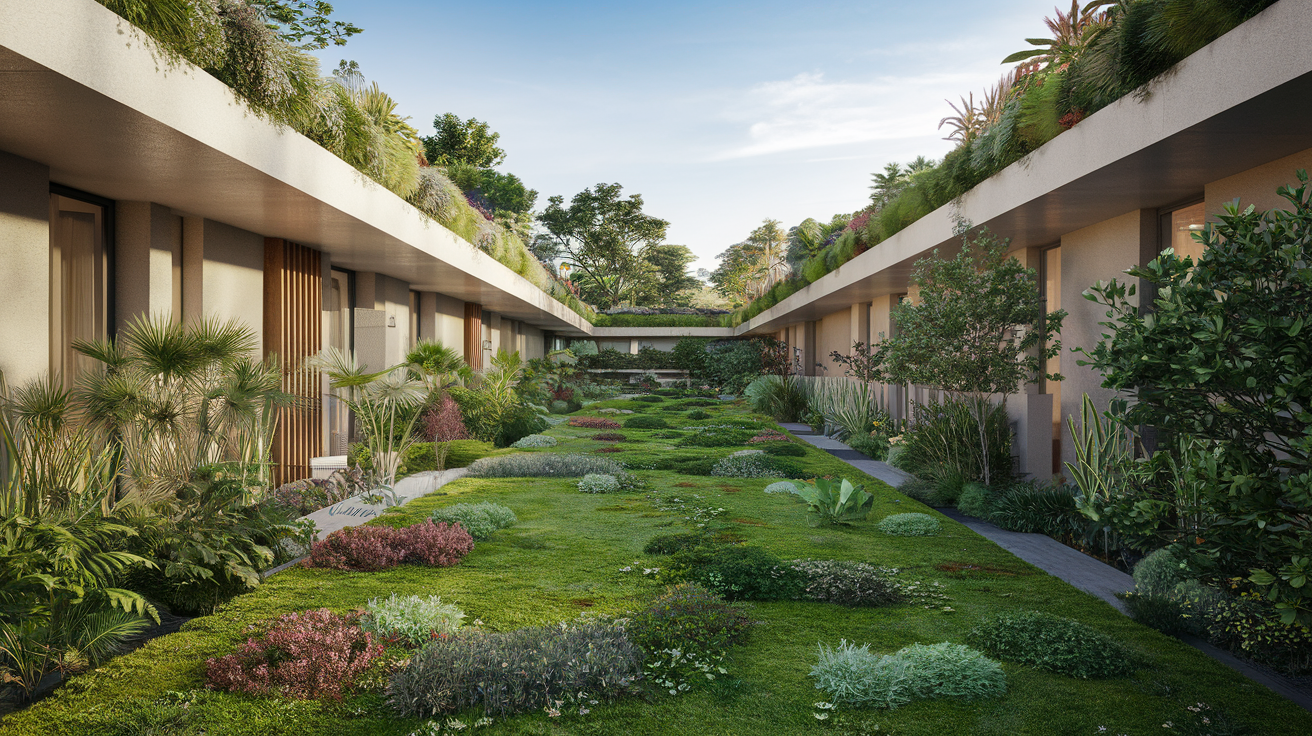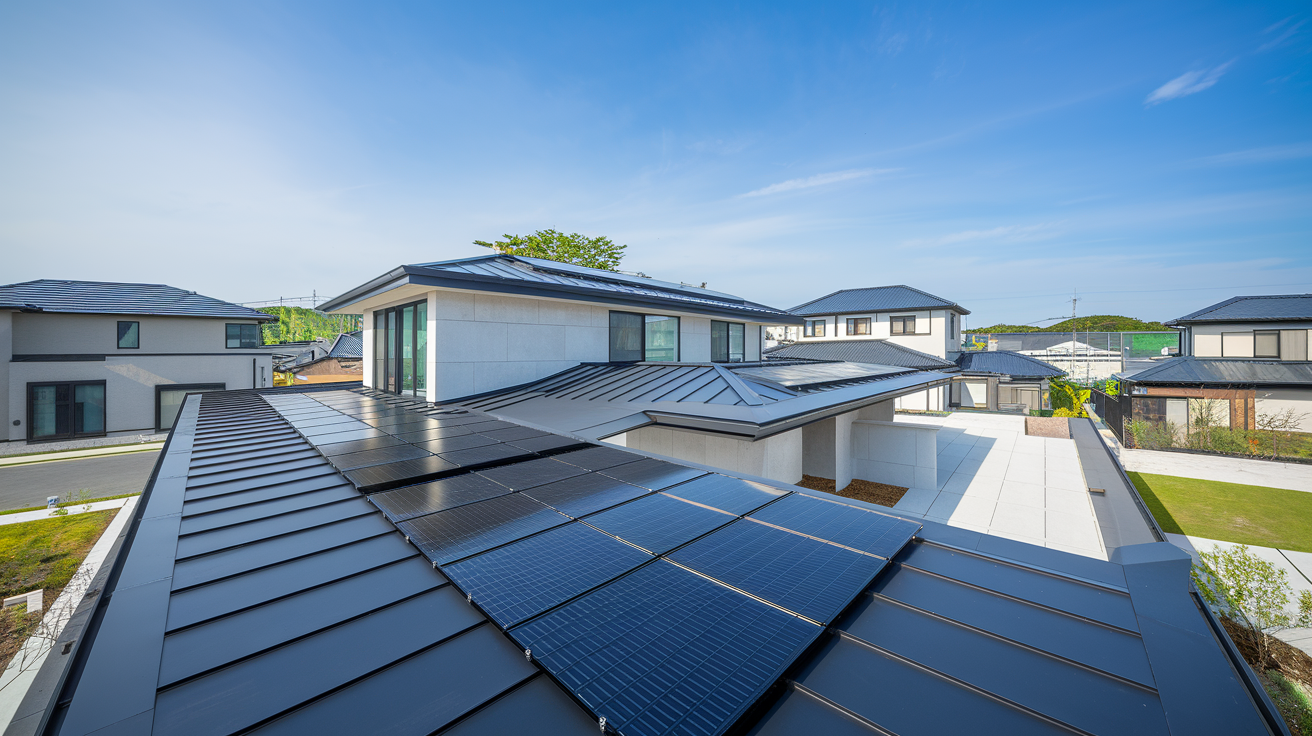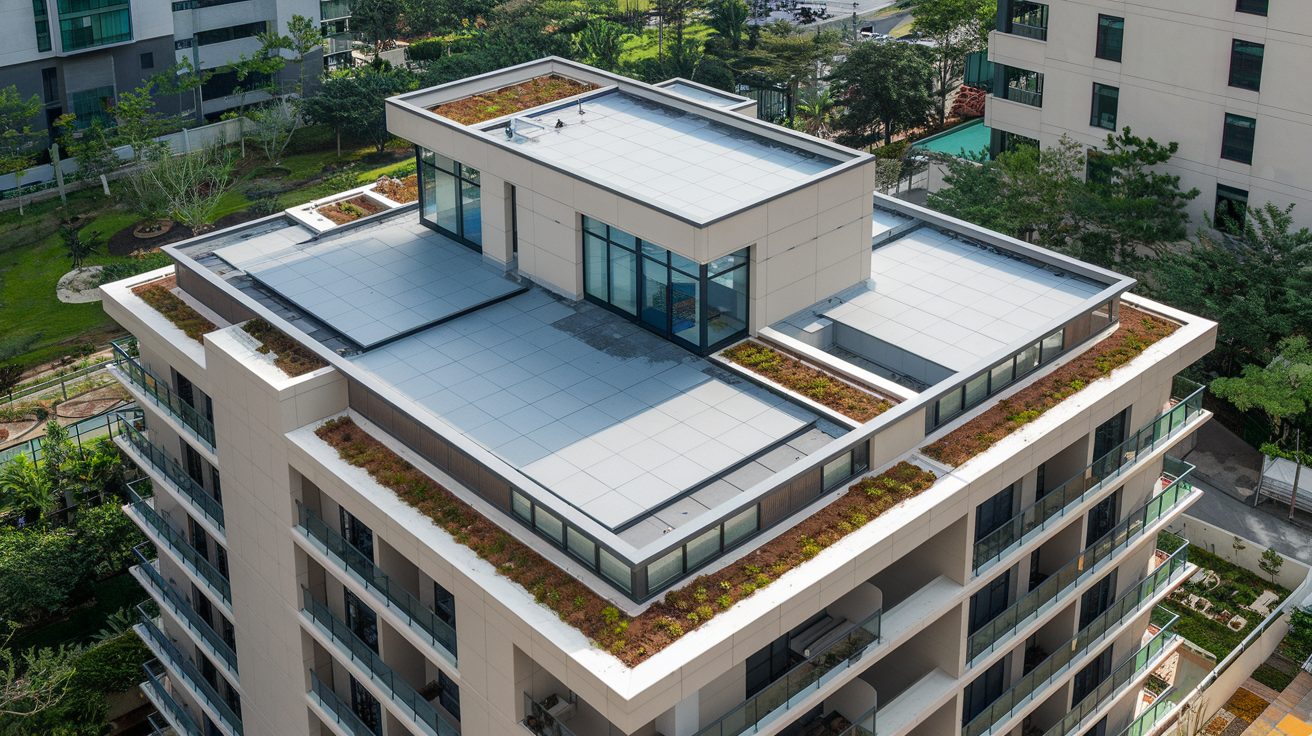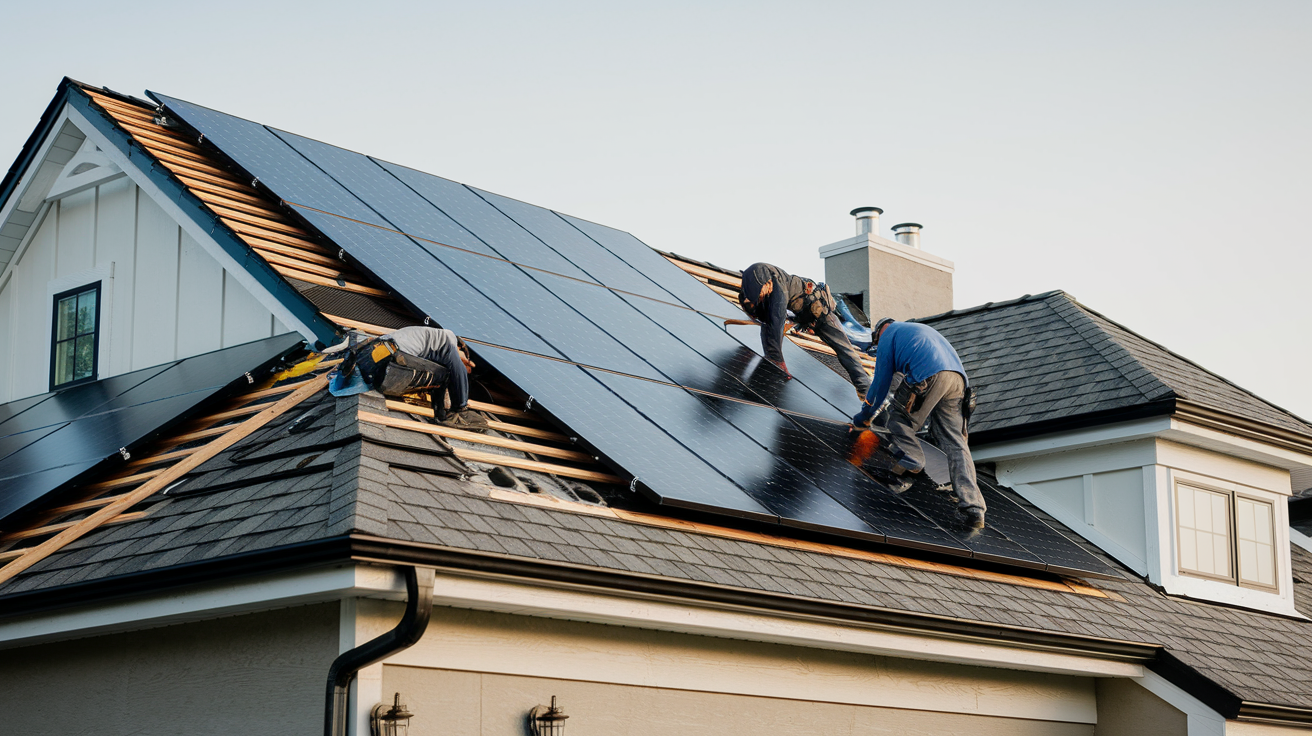Future of Roofing: 2024 Guide to Smart Home Technology & Savings
Your roof is more than just protection from the elements - it's about to become one of your home's smartest assets. With 70% of roofing companies reporting increased material costs in early 2023, homeowners face mounting pressure to make smarter, more sustainable roofing choices. But emerging technologies are creating exciting opportunities. From solar-integrated systems that slash energy bills to smart materials that detect leaks before they cause damage, the roofing industry is undergoing a dramatic transformation that could revolutionize home maintenance and efficiency.
In this comprehensive guide, you'll discover the cutting-edge materials and technologies reshaping residential roofing. We'll explore how innovations like cool roofs can reduce cooling costs by up to 15%, and why smart roofing systems are becoming a must-have feature for energy-conscious homeowners. You'll learn about sustainable options that not only protect your home but also increase its value in an increasingly eco-aware market.
Whether you're planning a roof replacement or simply want to stay ahead of the curve, understanding these advancements is crucial for making informed decisions about your home's future. Let's explore how these revolutionary changes in roofing technology could benefit you.
- Introduction to the Future of Roofing
- Emerging Roofing Technologies
- Advanced Roofing Materials
- Benefits for Homeowners
- Regional Considerations and Cost Implications
- Conclusion and Future Outlook
Introduction to the Future of Roofing
The roofing industry is changing rapidly. In 2024, we're seeing new technologies and sustainable solutions. This shift is driven by the need for energy efficiency, eco-friendly practices, and affordability. These trends affect how roofs are designed, built, and cared for. Homeowners want solutions that look good and save money while being environmentally friendly. They are interested in materials that lessen their home's impact on the planet. The future of roofing offers exciting changes that will meet these needs and set new standards. Consider getting a roof assessment to see how these advancements can benefit your home.
Overview of Current Roofing Technologies
Today's roofing uses both old and new methods. Traditional materials like asphalt shingles are still common, making up about 80% of residential roofs in 2023. Most homes have this material because it's affordable and easy to install. However, the industry is shifting towards greener options like green roofs (roofs with plants) and eco-friendly materials. These options are changing how cities look and making buildings more efficient. Eco-friendly materials give homeowners choices that are affordable, strong, and attractive. New manufacturing methods have made these materials even better. Cool roofing materials reflect sunlight and absorb less heat, becoming more popular because they save energy. This keeps homes cooler in the summer and can lower air conditioning bills. To learn more about roof maintenance and how new technologies can improve your home's efficiency, visit our comprehensive guide.
| Material Type | Benefits | Challenges |
|---|---|---|
| Traditional Asphalt Shingles | Affordable, Easy to Install | Less Energy Efficient, Shorter Lifespan |
| Eco-Friendly Materials | Energy Savings, Aesthetic Variety | Higher Initial Costs |

Importance of Innovation in Roofing
Roofing innovation is crucial. It tackles important issues like climate change, energy use, and rising material costs. Smart roofing systems save energy and increase home values. They offer features like real-time monitoring and maintenance alerts. Smart roofs can also react to weather changes, like adjusting airflow based on temperature. They can warn homeowners about problems, preventing costly repairs. This proactive approach helps roofs last longer. Material costs are increasing, with about 70% of roofing companies reporting cost increases in early 2023. This makes finding affordable and durable roofing solutions even more important. By using these innovations, homeowners can save on energy bills and maintenance. They can also reduce their impact on the environment. Roofing innovation is no longer a luxury; it's a necessity.
Emerging Roofing Technologies
The roofing industry is constantly evolving, with new technologies and materials offering homeowners more efficient, durable, and sustainable options. These advancements go beyond traditional roofing, providing benefits like energy savings, increased property value, and reduced environmental impact. This section explores three key emerging roofing technologies: smart roofing systems, solar roofing solutions, and cool roof technologies.
Smart Roofing Systems
Smart roofing systems represent a significant leap forward in roofing technology. These systems utilize sensors and other advanced technologies to monitor roof conditions in real-time, providing homeowners with valuable data and alerts. This proactive approach to roof management can help identify and address potential issues before they escalate into costly repairs.
Real-Time Monitoring and Maintenance
Smart roofs incorporate sensors that continuously monitor various aspects of roof health, including temperature, moisture levels, and even the detection of small leaks. This real-time data is accessible to homeowners remotely via smartphones or computers, providing immediate insights into their roof's condition. By detecting problems early, such as a damaged shingle or excessive moisture, smart roofing systems enable timely maintenance and prevent minor issues from developing into major problems. This proactive maintenance can significantly extend the lifespan of a roof and reduce overall maintenance costs. For a comprehensive roof analysis, consider our Get Your Roof Assessment.
Energy Efficiency and Cost Savings
Smart roofing systems can also contribute to energy efficiency. By adapting to environmental changes, such as adjusting ventilation based on temperature and humidity, these systems optimize energy consumption for heating and cooling. For instance, a smart roof can automatically increase ventilation during hot weather to reduce heat buildup in the attic, minimizing the need for air conditioning. Conversely, it can reduce ventilation during colder months to retain heat, improving heating efficiency. These adjustments can lead to lower energy bills and a smaller carbon footprint. To learn more about roof maintenance and its impact on energy efficiency, visit our dedicated resource page.
Enhanced Property Value
The integration of smart technology can significantly increase a property's market value. Homes equipped with smart roofing systems are often viewed as more desirable by potential buyers due to their advanced features, energy efficiency, and potential for long-term cost savings. This increased demand can translate into a higher resale value for homeowners who invest in smart roofing technology.

Solar Roofing Solutions
Solar roofing solutions are becoming increasingly popular as homeowners embrace renewable energy. These solutions integrate solar panels or shingles directly into the roof structure, generating electricity from sunlight and reducing reliance on traditional power sources.
Solar Shingles vs. Traditional Panels
Homeowners considering solar roofing have two main options: solar shingles and traditional solar panels. Solar shingles are designed to blend seamlessly with existing roofing materials, offering a more aesthetically integrated appearance. Traditional solar panels, while typically mounted on top of the roof, are often more cost-effective and offer potentially higher energy output. The choice between shingles and panels depends on individual preferences, budget, and energy needs.
| Feature | Solar Shingles | Traditional Panels |
|---|---|---|
| Aesthetic Integration | Seamless | Visible |
| Cost-Effectiveness | Higher | Lower |
| Energy Output | Moderate | High |
Environmental Benefits and Sustainability
Solar roofing offers significant environmental advantages. By generating clean energy, it reduces reliance on fossil fuels, minimizing carbon footprints and contributing to a more sustainable future. This shift towards renewable energy helps mitigate the effects of climate change and promotes a cleaner environment.
Financial Incentives and Return on Investment
Many governments and utility companies offer financial incentives, such as tax credits and rebates, to encourage the adoption of solar roofing. These incentives can significantly reduce the upfront installation cost, making solar roofing more accessible and financially attractive. Additionally, the long-term savings on energy bills can provide a substantial return on investment over time.
Cool Roof Technologies
Cool roof technologies focus on minimizing heat absorption and maximizing sunlight reflection. This approach helps keep buildings cooler, reducing the need for air conditioning and lowering energy consumption.
Energy Savings and Efficiency
Cool roofs utilize specialized materials with high solar reflectance and thermal emittance. By reflecting more sunlight and radiating absorbed heat, these roofs maintain lower temperatures compared to traditional roofing materials. This reduced heat absorption translates into lower cooling costs, particularly in warm climates.
Environmental Impact and Urban Heat Island Effect
Cool roofs contribute to mitigating the urban heat island effect, a phenomenon where urban areas experience significantly higher temperatures than surrounding rural areas. By reducing heat absorption, cool roofs help lower ambient temperatures in cities, creating a more comfortable and sustainable urban environment. This also contributes to lower energy demand and reduced greenhouse gas emissions.
Material Options and Aesthetics
A variety of cool roofing materials are available, including reflective coatings, tiles, and membranes. These options offer varying levels of solar reflectance and thermal emittance, allowing homeowners to choose a solution that best suits their needs and budget. Furthermore, cool roofing materials come in a range of colors and styles, allowing for aesthetic integration with different architectural designs.

Advanced Roofing Materials
The roofing industry is constantly evolving, with new materials and technologies emerging that offer improved sustainability, resilience, and longevity. Homeowners are increasingly seeking advanced roofing solutions that not only protect their homes but also contribute to energy efficiency and environmental conservation. The roofing material market, valued at $133.2 billion in 2023, is projected to grow significantly, reflecting this demand for innovative products. This growth is fueled by factors like increased housing construction and the need for more durable and sustainable roofing options. The global market is also on the rise, projected to reach $185.92 billion by 2032. For homeowners, understanding these advancements can lead to better choices and long-term savings. Consider getting a roof assessment to determine the best materials for your home.
Eco-Friendly Roofing Materials
Eco-friendly roofing materials are gaining traction as homeowners prioritize environmentally conscious choices. These materials minimize a building's carbon footprint by using recycled content and sustainable resources. They often offer benefits beyond environmental friendliness, such as energy efficiency and improved durability.
Benefits of Green Roofs
Green roofs offer a multitude of advantages. They enhance biodiversity by creating habitats for plants and insects, and improve air quality by absorbing pollutants. According to industry data, green roofs can lower building energy consumption by approximately 1% compared to conventional roofs on commercial buildings. This translates to a noticeable reduction in energy bills over time. Green roofs also provide cooling energy savings, sometimes as high as 15%, compared to insulated conventional roofs. This makes them a valuable solution for urban areas experiencing the heat island effect. While annual maintenance costs typically range from $0.13/ft² to $3.45/ft² for tasks like weeding and watering, the long-term environmental and energy-saving benefits often outweigh these costs. For a comprehensive understanding of roof maintenance, learn more about roof maintenance.
Cool Roofing Materials
Cool roofing materials are designed to reflect more sunlight and absorb less heat than traditional roofing materials. This high solar reflectance contributes to significant energy savings by reducing cooling costs, especially in warmer climates. Cool roofs can be a smart investment for homeowners looking to improve energy efficiency and lower their utility bills.
Impact-Resistant Roofing Options
With climate change impacting weather patterns, impact-resistant roofing options have become crucial for homeowners in vulnerable regions. These roofs are engineered to withstand severe weather events like hailstorms and high winds, minimizing the need for frequent repairs.
Asphalt Shingles
Asphalt shingles remain a popular choice, accounting for a significant majority of the residential roofing market. Modern asphalt shingles are increasingly designed for enhanced impact resistance and durability, reducing the need for replacements and repairs. This is especially important in regions experiencing more frequent and intense storms.
Metal Roofing for Durability
Metal roofs are renowned for their exceptional durability, often lasting more than 50 years with minimal upkeep, compared to the 25-35 year lifespan of traditional materials. Beyond impact resistance, they also offer excellent fire resistance, making them a safe and durable choice for homeowners in wildfire-prone areas. While the initial investment might be higher, the longevity and resilience of metal roofs result in lower long-term costs. Many metal roofing options are also made from recycled materials, further enhancing their sustainability.
Lightweight and Durable Roofing Innovations
Advances in materials science have resulted in the creation of lightweight yet durable roofing materials. These innovations are particularly advantageous for structures with limited load-bearing capacity, such as older buildings or those with unique architectural designs. The reduced weight can also simplify installation and lower transportation costs.
Synthetic Roofing Materials
Synthetic roofing materials, like polymer-based tiles, provide an excellent balance of weight and strength. They can mimic the appearance of traditional materials like slate or wood while being significantly lighter and more resistant to wear and tear. This makes them an appealing option for homeowners who desire the aesthetic of traditional roofing without the added weight and maintenance. These innovations are shaping the future of the roofing industry, providing practical solutions without compromising aesthetics or performance.
Benefits for Homeowners
The roofing industry is transforming, offering homeowners several key advantages. Modern technologies and materials provide better energy efficiency, increased durability, and higher property values. These advancements address issues with older roofs while offering sustainable and cost-effective solutions. Upgrading your roof may be a wise investment for your home.
Energy Efficiency and Cost Savings
Modern roofing offers significant energy efficiency and cost savings. Cool roofs reflect more sunlight and absorb less heat than traditional roofs, resulting in lower cooling costs. Cool roofs achieve this through higher solar reflectance and thermal emittance. Smart roofing systems adapt to weather changes, providing real-time data on roof conditions and alerting homeowners to potential leaks or temperature fluctuations. Homes with energy-efficient roofs can save somewhere between 10% and 15% on annual energy bills. Smart systems track energy use and identify potential issues like leaks, enabling proactive maintenance and additional cost savings. Consider scheduling a Get Your Roof Assessment to determine your potential savings.
Enhanced Durability and Longevity
Roofing materials are more durable and long-lasting than ever. Traditional roofs last 25-35 years, but newer materials like metal can last over 50 years with less maintenance. This reduces long-term costs by minimizing replacements. Advanced materials withstand harsh weather better, reducing the need for frequent repairs. This added resistance to wind, rain, and snow minimizes damage and repair expenses. Eco-friendly options like recycled rubber offer durability and environmental sustainability. For example, a recycled rubber green roof can save up to 14.8% on cooling energy compared to a traditional insulated roof. Green roofs require annual maintenance, costing between $0.13 and $3.45 per square foot, depending on weed control and watering needs. To learn more about roof maintenance, visit our comprehensive guide.
Increased Property Value
Modern roofing upgrades increase home values. Energy-efficient technologies are popular in real estate, with smart roofs being a strong selling point. Sustainable and technologically advanced roofs increase appraisal values, offering a good return on investment. This added value also positions homes as sustainable, appealing to eco-conscious buyers. Features like green roofs and solar-integrated designs improve aesthetics and functionality, making homes more competitive. In conclusion, the future of roofing benefits homeowners in several ways, from energy savings and durability to higher property values. Adopting new technologies and materials creates a more sustainable, efficient, and valuable home.
Regional Considerations and Cost Implications
Understanding regional factors and cost implications is crucial for homeowners investing in new roofing technology. As the roofing industry evolves with new materials and technologies, it's essential to evaluate how these advancements fit local climates, budgets, and building codes. Making informed choices can lead to big long-term savings and increased property value.
Climate Suitability and Regional Adoption
Different regions experience unique weather patterns that influence the best roofing technologies. For example, hot, sunny areas benefit from cool roofs. These roofs reflect more sunlight and absorb less heat than standard roofs, lowering cooling costs. Areas with heavy rain or snow need tough, weather-resistant materials like metal roofs, known for their durability. Metal roofs also stand up well to hailstorms. They can last 50+ years, while traditional roofs last 25-35 years. In cities, green roofs are gaining popularity to combat the urban heat island effect, where cities are much hotter than surrounding areas. Green roofs absorb rainwater, reduce runoff, and offer insulation. Get Your Roof Assessment to determine the most suitable roofing materials for your specific climate.
Installation Costs and Long-Term Savings
New roofing systems can cost more upfront than traditional options but offer significant long-term savings. For example, asphalt shingle replacement costs $24,700 on average, while metal roofing costs $40,318. But a metal roof's longer lifespan can offset the higher initial price. Smart roofing systems provide real-time data on roof conditions, lowering maintenance costs by catching problems early. They can detect leaks, track energy use, and adjust to weather changes, reducing inspections and repairs. Learn more about roof maintenance to understand the benefits of preventative maintenance with smart roofing. Energy-efficient options like solar roofing can also cut electricity bills, offering a return on investment in a few years. While solar roofs can greatly reduce energy use, actual savings depend on factors like roof angle, sun exposure, and energy consumption. Smart roofs can also boost property value, as energy-efficient homes are in demand.
Building Codes and Regulations
Building codes and regulations are important for adopting new roofing technologies. Many areas now have energy efficiency standards that encourage eco-friendly materials like cool roofs and solar panels. Homeowners should know local rules to ensure compliance and access incentives for sustainable roofing. This understanding can simplify installation and avoid costly delays or changes. Solar panel installation often faces challenges like roof load capacity, shading, electrical wiring, inverter compatibility, and permits. In conclusion, regional factors and cost implications are key to selecting the right roofing technology. By considering climate, installation costs, long-term savings, and building codes, homeowners can make smart choices that improve their property's value and sustainability.

Conclusion and Future Outlook
The roofing industry is transforming, thanks to new technologies and a focus on sustainability. As we approach 2024, homeowners can expect exciting innovations. These innovations will improve how roofs work and last, and they'll also be better for the environment. Some examples include solar technology, smart roofing systems, and eco-friendly materials. These changes offer homeowners a chance to help the environment, save money on energy, and increase their home's value. Consider getting a roof assessment to explore how these advancements can benefit your home.
Anticipated Trends in Roofing Technology
Several key trends are expected to shape the roofing industry in the coming years.
Solar-Integrated Roofing
Solar-integrated roofing is becoming more popular. It allows homeowners to create energy and save money on their utility bills. This can mean lower electricity costs and less reliance on traditional power sources. Solar-integrated roofing includes solar shingles or tiles. These are built into the roof and create electricity from sunlight. Learn more about roof maintenance and how solar integration can impact your needs.
Smart Roofing Systems
Smart roofing systems provide real-time data about your roof's condition. They can also alert you to potential maintenance needs. These systems are expected to become more common. They can adapt to weather changes and help homeowners decide about repairs. Sensors in the roof monitor things like temperature, moisture, and wind speed. This information goes to a central hub that the homeowner can access. This allows for early detection of leaks or damage, preventing costly repairs.
Cool Roofing Materials
Cool roofing materials reflect more sunlight. They help make homes more energy-efficient by reducing the need for air conditioning. This can lead to significant energy savings, especially in warmer areas. Cool roofing materials include special coatings, tiles, or shingles. These are designed to reflect sunlight and heat away from the building.
How Homeowners Can Prepare and Adapt
Homeowners can take steps to benefit from these new technologies.
Education and Research
First, learn about the different roofing options available. Understanding these technologies, like solar shingles and smart roofing, helps homeowners make smart choices. For example, knowing how much energy solar shingles can produce can help decide if they're a good investment. Homeowners don't need to be roofing experts. But understanding the basics can help them make better choices.
Professional Consultation
Talking to roofing professionals is important. They can help you choose the best materials and technologies for your home, climate, and budget. This includes discussing the lifespan of different materials. For example, metal roofs can last over 50 years, while traditional roofs last 25-35 years. Professionals can also discuss energy efficiency and the overall costs and benefits of different roofing choices. Consulting a professional is recommended before any major roofing decision, especially when considering new technologies.
Staying Updated
Staying current with industry trends and innovations is helpful. Use reputable sources to stay informed about the future of roofing. This might involve reading industry publications or attending online seminars. Even checking in on industry news periodically can help homeowners stay aware of important developments. This can help you make your home more efficient, resilient, and sustainable.
Disclaimer: This blog post is intended for informational purposes only and should not be considered professional roofing advice. Always consult with qualified roofing contractors and insurance professionals for specific guidance regarding your individual circumstances.
